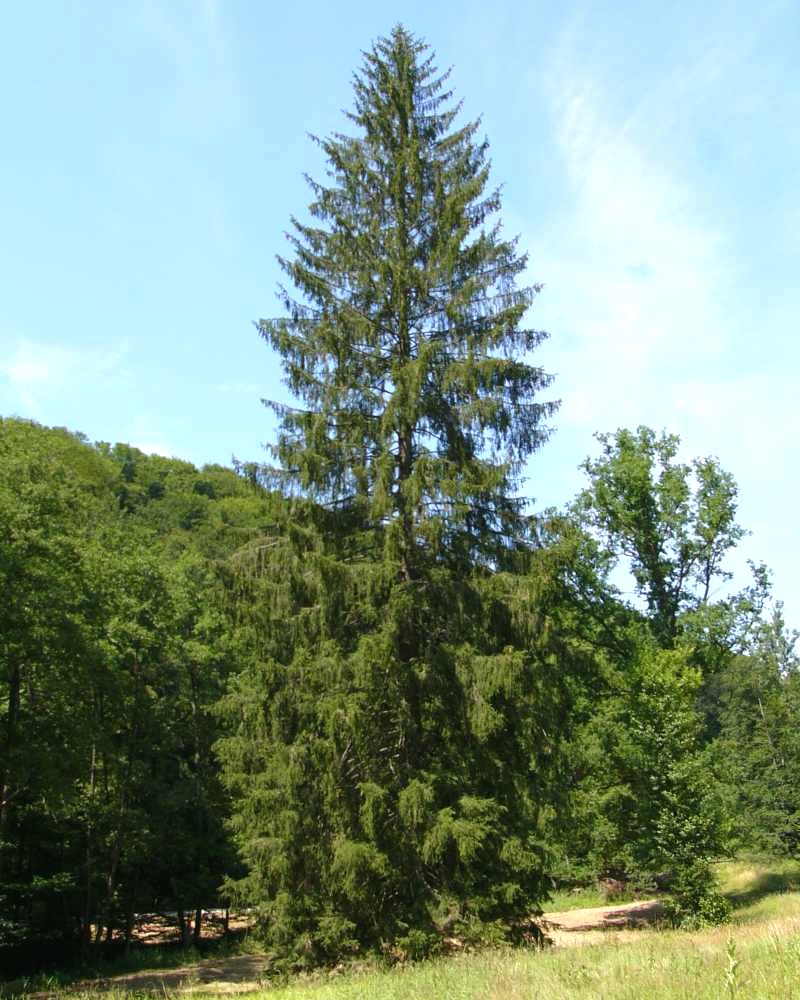- Norway Spruce
Taxobox
name = Norway Spruce
status = LR/lc | status_system = IUCN2.3

image_width = 240px
image_caption = Norway Spruce
regnum =Plant ae
divisio =Pinophyta
classis = Pinopsida
ordo =Pinales
familia =Pinaceae
genus = "Picea"
species = "P. abies"
binomial = "Picea abies"
binomial_authority = (L.) H.Karst.Norway Spruce ("Picea abies") is a species of
spruce native toEurope . It is a largeevergreen conifer oustree growing to 35-55 m tall and with a trunk diameter of up to 1-1.5 m. The shoots are orange-brown and glabrous (hairless). The leaves are needle-like, 12-24 mm long, quadrangular in cross-section (not flattened), and dark green on all four sides with inconspicuousstoma tal lines. The cones are 9-17 cm long (the longest of any spruce), and have bluntly to sharply triangular-pointed scale tips. They are green or reddish, maturing brown 5-7 months after pollination. Theseed s are black, 4-5 mm long, with a pale brown 15 mm wing.Farjon, A. (1990). "Pinaceae. Drawings and Descriptions of the Genera". Koeltz Scientific Books ISBN 3-87429-298-3.] Rushforth, K. (1987). "Conifers". Helm ISBN 0-7470-2801-X.] Gymnosperm Database: [http://www.conifers.org/pi/pic/abies.htm "Picea abies"] ] [IUCN2006|assessors=Conifer Specialist Group|year=1998|id=42318|title=Picea abies|downloaded=12 May 2006] [Den Virtuella Floran: [http://linnaeus.nrm.se/flora/barr/pina/picea/piceabiv.jpg"Picea abies" distribution (in Swedish, with maps)] ]The Norway Spruce grows throughout northeast
Europe fromNorway andPoland eastward, and also in themountain s of central Europe, southwest to the western end of theAlps , and southeast in the Carpathians andBalkans to the extreme north ofGreece . The northern limit is in thearctic , just north of 70°N in Norway. Its eastern limit inRussia is hard to define, due to extensive hybridisation and intergradation with theSiberian Spruce ("Picea obovata",syn. "P. abies "subsp." obovata"), but is usually given as theUral Mountains . However, trees showing some Siberian Spruce characters extend as far west as much of northernFinland , with a few records in northeast Norway. The hybrid is known as "Picea x fennica" (or "P. × "subsp." fennica", if the twotaxa are consideredsubspecies ), and can be distinguished by a tendency towards having hairy shoots and cones with smoothly rounded scales.Populations in southeast Europe tend to have on average longer cones with more pointed scales; these are sometimes distinguished as "Picea abies" var. "acuminata" (Beck) Dallim. & A.B.Jacks., but there is extensive overlap in variation with trees from other parts of the range.
Some botanists treat
Siberian Spruce as a subspecies of Norway Spruce, though in their typical forms, they are very distinct, the Siberian Spruce having cones only 5-10 cm long, with smoothly rounded scales, and pubescent (hairy) shoots.Genetically Norway and Siberian Spruces have turned out to be extremely similar and should be considered as two closely relatedsubspecies of "P. abies" [Krutovskii, K.V. & Bergmann, F.: "Introgressive hybridization and phylogenetic relationships between Norway, Picea abies (L.) Karst., and Siberian, P. obovata Ledeb., spruce species studied by isozyme loci." - Heredity 74 (1995): 464-480. http://www.nature.com/hdy/journal/v74/n5/pdf/hdy199567a.pdf ] .Another spruce with smoothly rounded cone scales and hairy shoots occurs rarely in the central Alps in eastern
Switzerland . It is also distinct in having thicker, blue-green leaves. Many texts treat this as a variant of Norway Spruce, but it is as distinct as many other spruces, and appears to be more closely related to Siberian Spruce,Schrenk's Spruce ("P. schrenkiana") from centralAsia andMorinda Spruce ("P. smithiana") in theHimalaya . Treated as a distinct species, it takes the name Alpine Spruce ("Picea alpestris" (Brügger) Stein). As with Siberian Spruce, it hybridises extensively with Norway Spruce; pure specimens are rare.The tallest measured tree, 63 m tall, is in Perucica Virgin Forest, Sutjeska National Park, Bosnia-Herzegovina.
A press release from
Umeå University says that a Norway Spruce clone namedOld Tjikko , carbon dated as 9,550 years old, is the "oldest living tree." [ [http://www.info.umu.se/NYHETER/PressmeddelandeEng.aspx?id=3061 Umeå University Press Release: World’s oldest living tree discovered in Sweden] . April 16, 2008.] However, Pando, a Quaking Aspen clone, is estimated to be between 80,000 and one million years old. [ [http://www.nps.gov/brca/naturescience/quakingaspen.htm Quaking Aspen] by theBryce Canyon National Park Service ] [Genetic Variation and the Natural History of Quaking Aspen, Mitton, J. B. & Grant, M. C. (1996). "BioScience" 46 (1): 25-31.] The oldest known individual tree is Methuselah, a Great Basin Bristlecone Pine.Cultivation and uses
Norway Spruce is one of the most widely planted spruces, both in and outside of its native range, used in
forestry fortimber andpaper production, and as an ornamental tree inpark s andgarden s. It is also widely planted for use as aChristmas tree . Every Christmas, the Norwegian capital city ofOslo provides the cities ofNew York ,London ,Edinburgh andWashington D.C. with a Norwegian spruce, which is placed at the most central square of each city. This is mainly a sign of gratitude for the aid these countries gave during the Second World War.It is naturalised in some parts of
North America , though not so extensively as to be considered an invasiveweed tree. It can grow fast when young, up to 1 m per year for the first 25 years under good conditions, but becomes slower once over around 20 m tall.Mitchell, A. F. (1974). "A Field Guide to the Trees of Britain and Northern Europe". Collins ISBN 0-00-212035-6]Several
cultivar s have been selected for garden use.References
Wikimedia Foundation. 2010.
